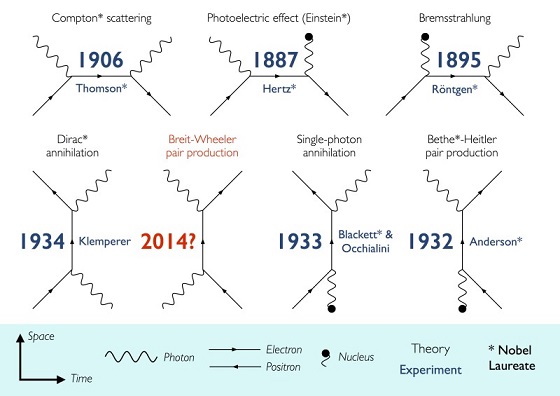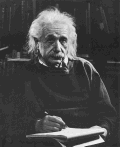به گزارش همشهری آنلاین، نور و ماده از نظر تئوری
قابل تبادل هستند اما نمایش عملی این نظریه تاکنون
امکانپذیر نبودهاست. فیزیکدانان مدتها است که
برای ایجاد ماده از نور به مطالعه پرداختهاند و
در تلاشند تا ۱۲ ماه آینده شدنی بودن آن را به
نمایش بگذارند. نظریهای که این ایده را مطرح
میکند، اولین بار در حدود ۸۰ سال پیش توسط دو
فیزیکدان به نامهای گریگوری بریت و جان ویلر که
بعدها درگیر ساخت بمبهای اتمی شدند، ارائه شد.
در آن زمان آن فیزیکدانان تبدیل نور به ماده را در
آزمایشگاه غیرممکن توصیف کردند.
اما در گزارشی که در روز یکشنبه منتشر شد،
فیزیکدانان کالج امپریال لندن ادعا کردند این مشکل
را به واسطه لیزرهای پرقدرت و دیگر تجهیزات موجود
برطرف ساختهاند. فیزیکدانان این دانشگاه در
آستانه ایجاد دستگاهی قرار ندارند که با برخورد
پرتو لیزری میتواند هرمادهای را تولید کند، بلکه
نوع ماده ایجاد شده توسط نور، ذرات تحت اتمی است
که با چشم غیر مسلح نمیتوان آنها را دید. در سال
۱۹۳۴ بریت و ویلر بر احتمال ترکیب دو ذره نور و
ایجاد یک الکترون و ضد الکترون، یا همان پوزیترون،
از این ترکیب مطالعه میکردند. الکترونها ذراتی از
ماده هستند که پوسته خارجیتر اتم را تشکیل
میدهند. اما این دو دانشمند انتظار این را
نداشتند که به این زودیها نظریه آنها به اثبات
برسد. در آن مطالعه فیزیکدانان متوجه شدند این
فرایند تا اندازهای نادر و دشوار است که مشاهده
آن در محیط آزمایشگاهی غیرممکن خواهد بود.
اما محققان در مطالعه جدید معتقدند این فرایند یکی
از سادهترین شیوههای ایجاد ماده از نور بوده و
نابترین نمایش فرمول مشهور E=mc2 است. دانشمندان
در مقاله خود نحوه تبدیل نور را طی چندین مرحله
جداگانه تشریح کردهاند. در مرحله اول الکترونها
به تکهای طلا شلیک میشوند و به این شکل
فوتونهایی پرانرژی ایجاد میشوند. سپس پرتوهای
پرانرژی لیزری داخل کپسول طلایی کوچکی به نام
هولرائوم ( به زبان آلمانی به معنی اتاقک خالی)
تابانده میشوند و نوری به درخشش نور ستارگان
ایجاد میشود. در مرحله نهایی نیز فوتونها وارد
کپسول شده و با فوتونهای اولیه برخورد میکنند.
محاسبات فیزیکدانان نشان میدهد به این شکل مقدار
مناسبی از ذرات نور توسط انرژی بالایی در حجمی
کوچک فشرده میشوند و به این شکل ۱۰۰ هزار جفت
الکترون-پوزیترون ایجاد میشود. این فرایند یکی از
دیدنیترین پیش بینیهای نظریه کوانتوم
الکترودینامیک است که در آغاز جنگ جهانی دوم مطرح
شد. دانشمندان امیدوارند بتوانند تا ۱۲ ماه دیگر
این آزمایش را به نمایش بگذارند. در سرتاسر جهان
چندین آزمایشگاه فیزیکی با قابلیت انجام چنین
آزمایشی وجود دارد که یکی از آنها مرکز لیزر اومگا
در روچستر آمریکا است. موفقیت در انجام این آزمایش
میتواند فیزیکدانها را در ایجاد
برخورددهندههای فوتونی به عنوان ابزاری برای
مطالعه بر رفتارهای ذرات تحت اتمی تشویق کند.
This shows theories describing light and
matter interactions.
Credit: Oliver Pike, Imperial College
London
mperial College
London physicists have discovered how to
create matter from light -- a feat thought
impossible when the idea was first theorised
80 years ago.
In just one day over several cups of coffee
in a tiny office in Imperial's Blackett
Physics Laboratory, three physicists worked
out a relatively simple way to physically
prove a theory first devised by scientists
Breit and Wheeler in 1934.
Breit and Wheeler suggested that it should
be possible to turn light into matter by
smashing together only two particles of
light (photons), to create an electron and a
positron -- the simplest method of turning
light into matter ever predicted. The
calculation was found to be theoretically
sound but Breit and Wheeler said that they
never expected anybody to physically
demonstrate their prediction. It has never
been observed in the laboratory and past
experiments to test it have required the
addition of massive high-energy particles.
The new research, published in Nature
Photonics, shows for the first time how
Breit and Wheeler's theory could be proven
in practice. This 'photon-photon collider',
which would convert light directly into
matter using technology that is already
available, would be a new type of
high-energy physics experiment. This
experiment would recreate a process that was
important in the first 100 seconds of the
universe and that is also seen in gamma ray
bursts, which are the biggest explosions in
the universe and one of physics' greatest
unsolved mysteries.
The scientists had been investigating
unrelated problems in fusion energy when
they realised what they were working on
could be applied to the Breit-Wheeler
theory. The breakthrough was achieved in
collaboration with a fellow theoretical
physicist from the Max Planck Institute for
Nuclear Physics, who happened to be visiting
Imperial.
Demonstrating the Breit-Wheeler theory would
provide the final jigsaw piece of a physics
puzzle which describes the simplest ways in
which light and matter interact (see image
in notes to editors). The six other pieces
in that puzzle, including Dirac's 1930
theory on the annihilation of electrons and
positrons and Einstein's 1905 theory on the
photoelectric effect, are all associated
with Nobel Prize-winning research (see
image).
Professor Steve Rose from the Department of
Physics at Imperial College London said:
"Despite all physicists accepting the theory
to be true, when Breit and Wheeler first
proposed the theory, they said that they
never expected it be shown in the
laboratory. Today, nearly 80 years later, we
prove them wrong. What was so surprising to
us was the discovery of how we can create
matter directly from light using the
technology that we have today in the UK. As
we are theorists we are now talking to
others who can use our ideas to undertake
this landmark experiment."
The collider experiment that the scientists
have proposed involves two key steps. First,
the scientists would use an extremely
powerful high-intensity laser to speed up
electrons to just below the speed of light.
They would then fire these electrons into a
slab of gold to create a beam of photons a
billion times more energetic than visible
light.
The next stage of the experiment involves a
tiny gold can called a hohlraum (German for
'empty room'). Scientists would fire a
high-energy laser at the inner surface of
this gold can, to create a thermal radiation
field, generating light similar to the light
emitted by stars.
They would then direct the photon beam from
the first stage of the experiment through
the centre of the can, causing the photons
from the two sources to collide and form
electrons and positrons. It would then be
possible to detect the formation of the
electrons and positrons when they exited the
can.
Lead researcher Oliver Pike who is currently
completing his PhD in plasma physics, said:
"Although the theory is conceptually simple,
it has been very difficult to verify
experimentally. We were able to develop the
idea for the collider very quickly, but the
experimental design we propose can be
carried out with relative ease and with
existing technology. Within a few hours of
looking for applications of hohlraums
outside their traditional role in fusion
energy research, we were astonished to find
they provided the perfect conditions for
creating a photon collider. The race to
carry out and complete the experiment is
on!"
The research was funded by the Engineering
and Physical Sciences Research Council
(EPSRC), the John Adams Institute for
Accelerator Science, and the Atomic Weapons
Establishment (AWE), and was carried out in
collaboration with Max-Planck-Institut für
Kernphysik.
Source:
Science Daily




